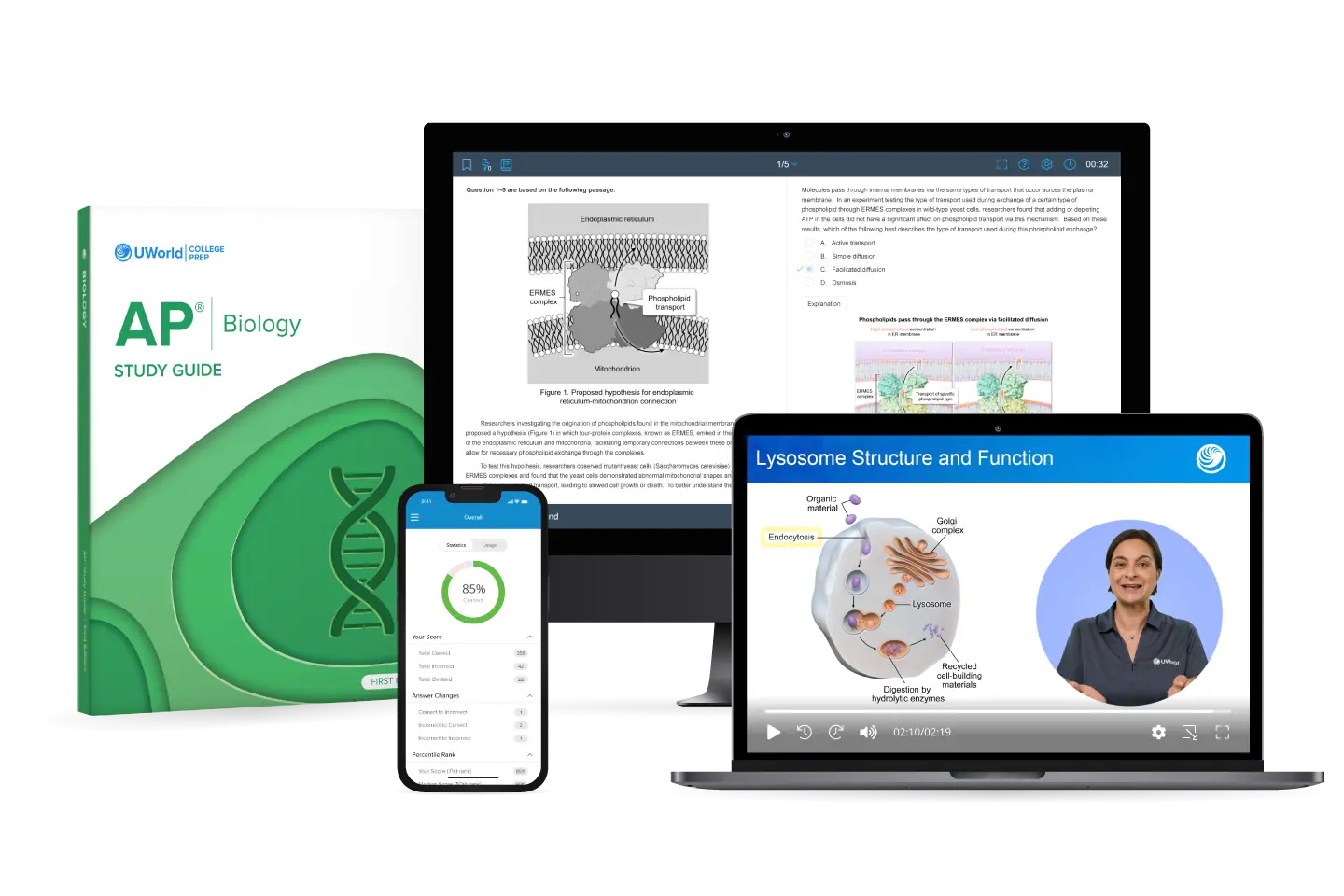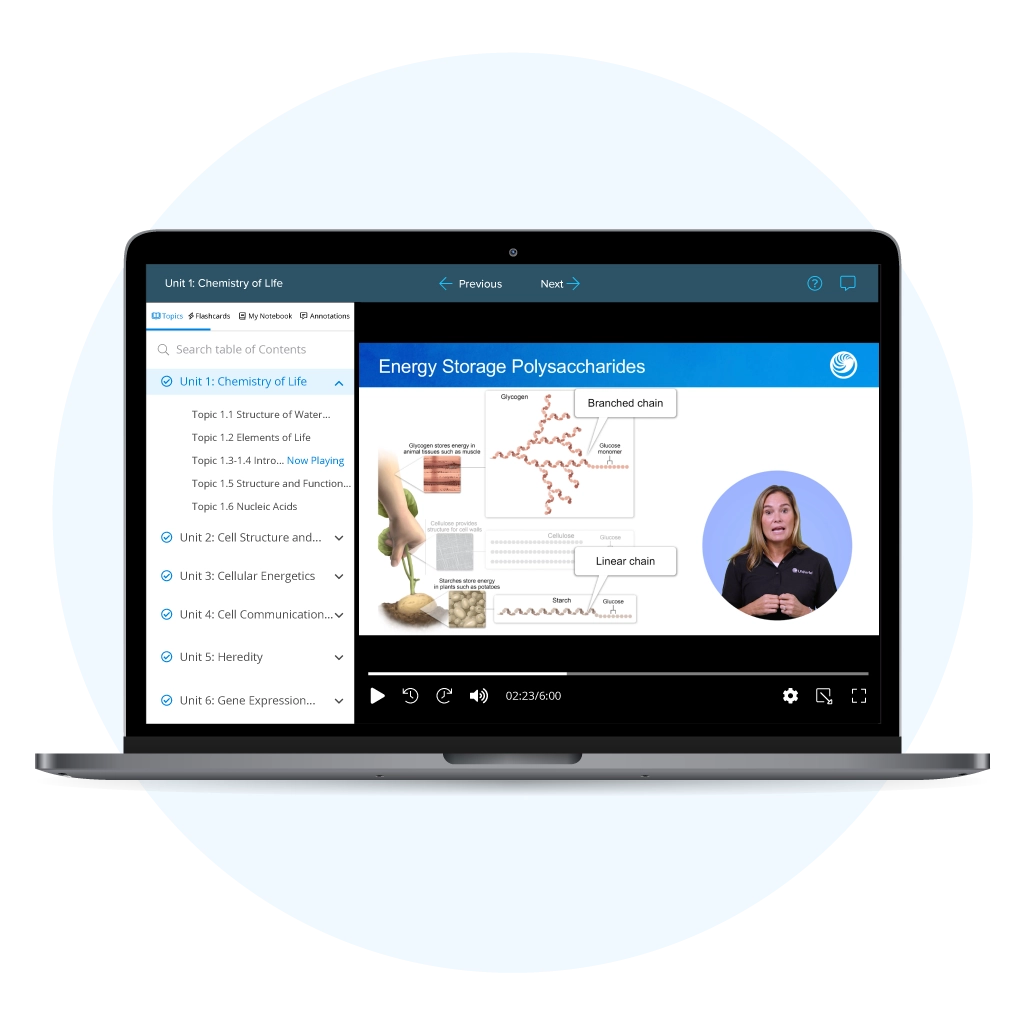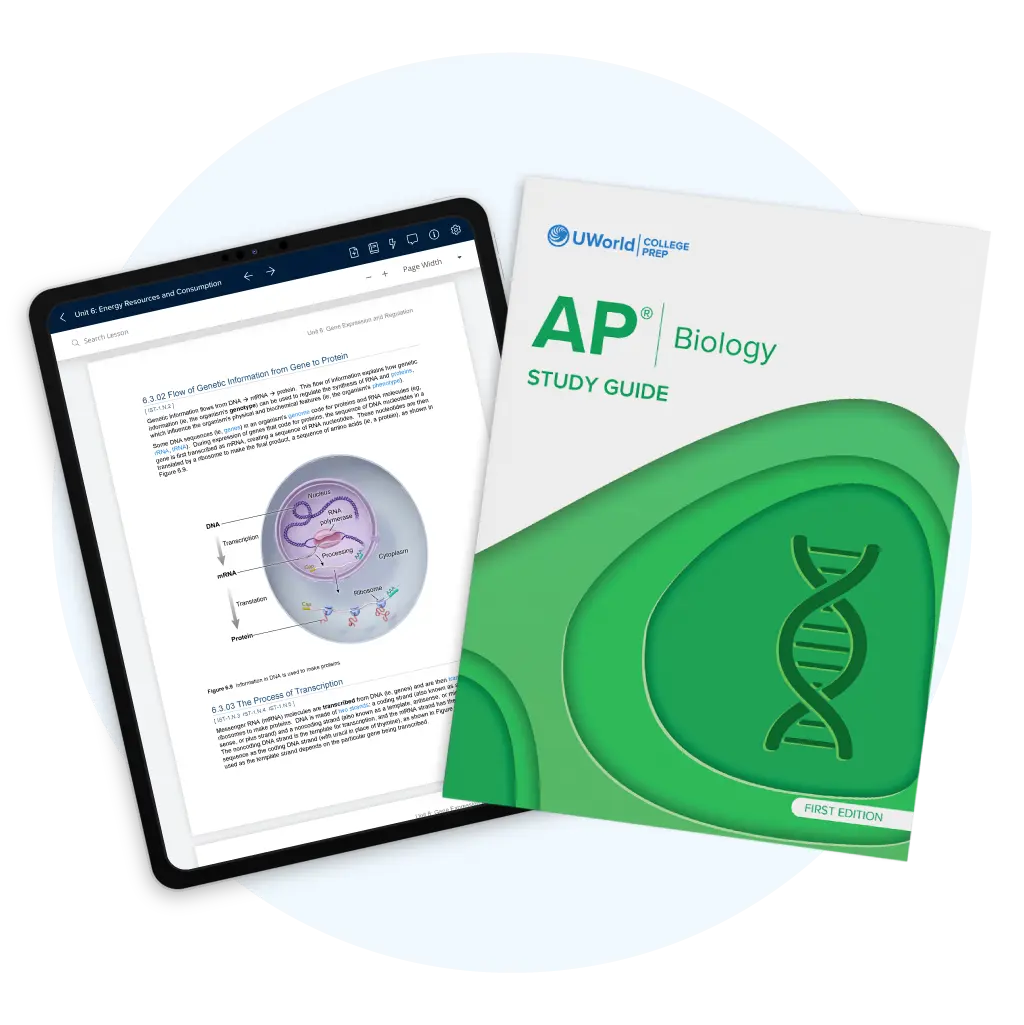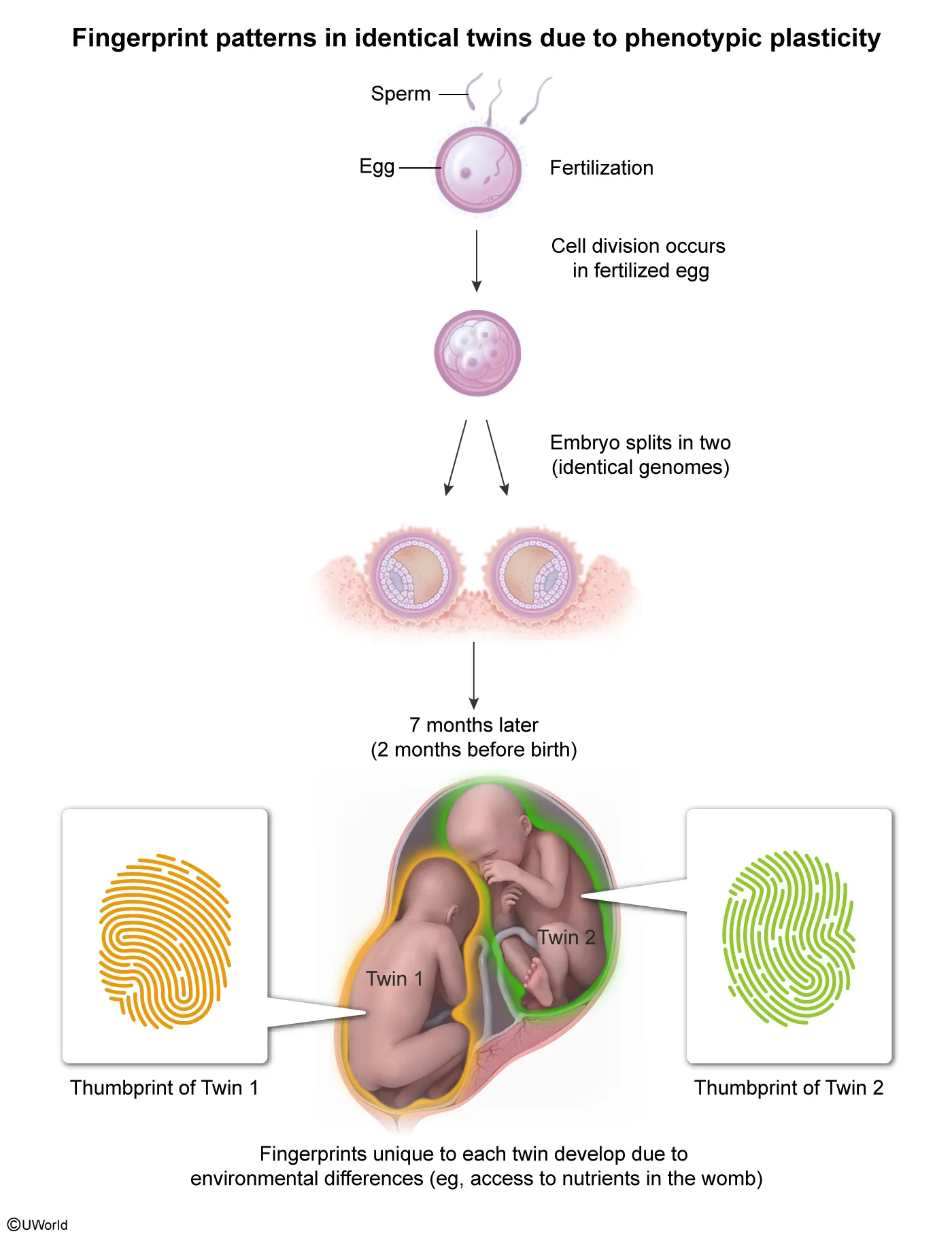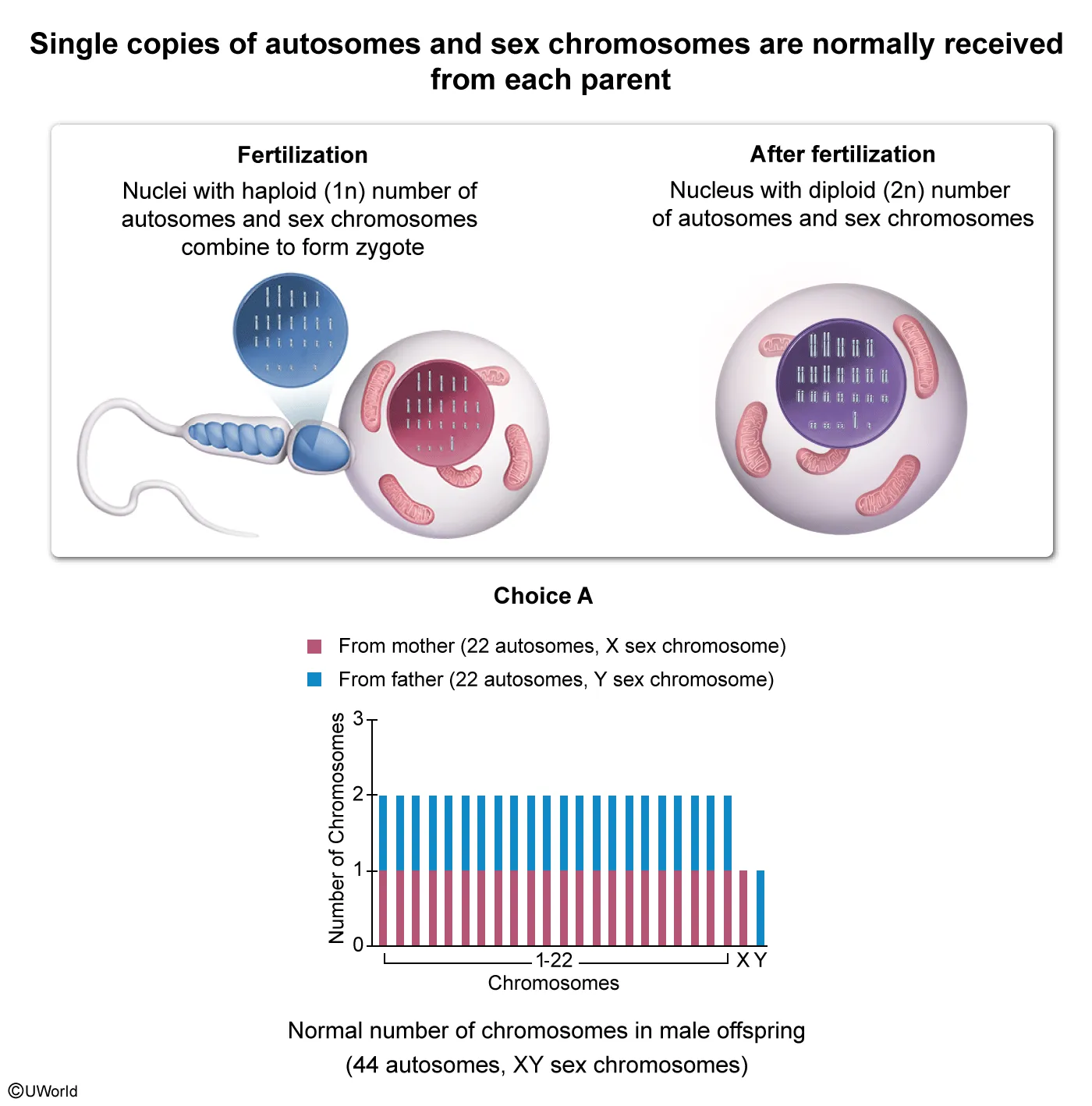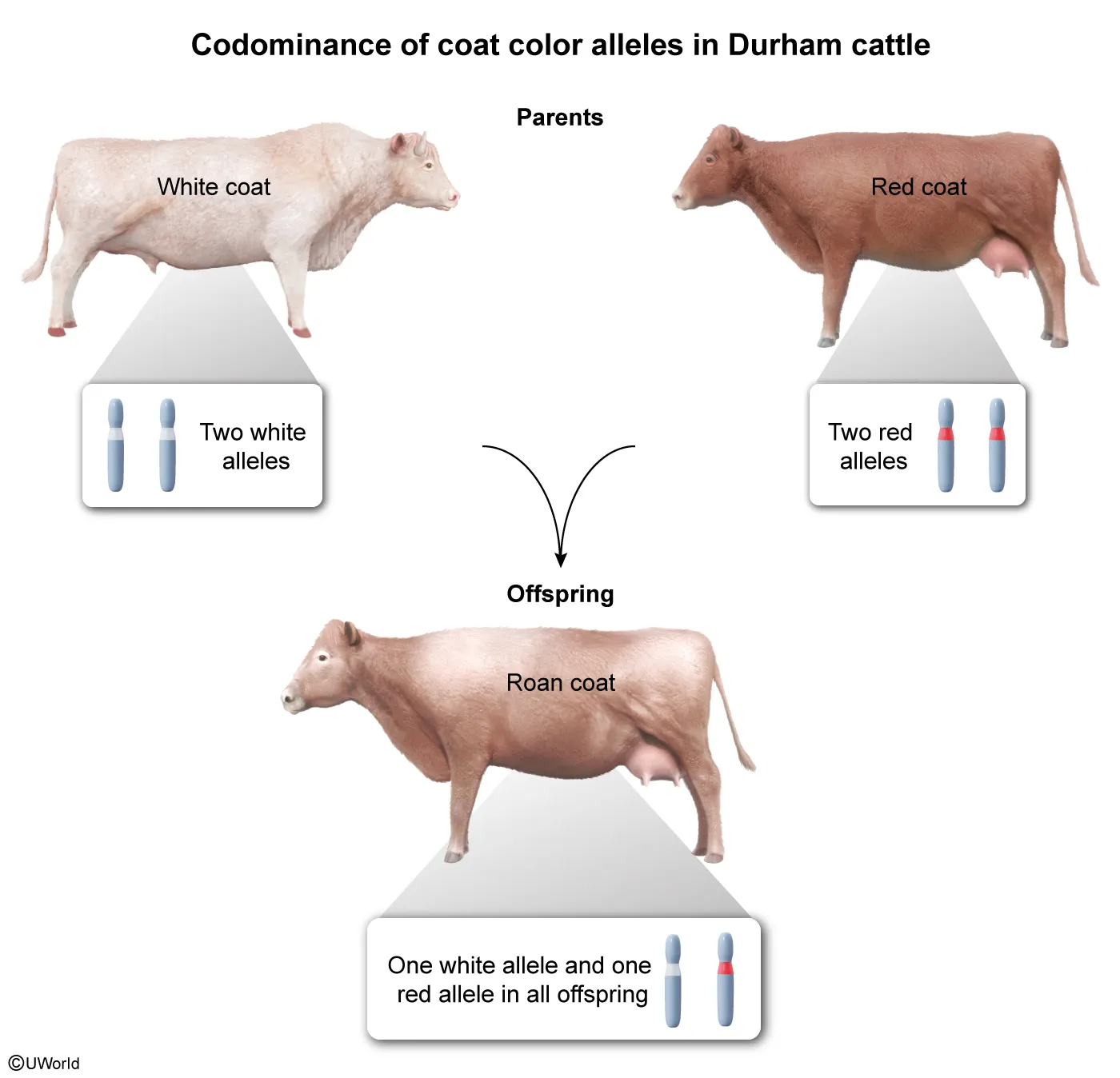AP Biology Unit 5 Review and Practice Test
AP Biology Unit 5, Heredity, covers the fundamental principles of inheritance and gives students the foundation to understand how traits and genes are passed, expressed, and mutated over generations. So, get closer to achieving the perfect 5 with UWorld's AP Bio Unit 5 review, which includes practice questions, study guides, and review videos delivered by experts, all in one place.
Flip the Script: Make AP Bio Unit 5 Your Genetic Advantage, Not an Inherited Problem
Don’t let Heridity be the unit that throws you off on the text day. Instead, use our comprehensive AP Bio Unit 5 review with clear explanations, video lessons that make you master the concepts in record time, and targeted practice that translates learning into perfection.
Videos That Make Heridity Click
With topics like meiosis, gene interactions, and chromosomal inheritance, Heredity becomes a complex unit that takes up much time. Not anymore! Each video makes learning Heredity easier, as it comes with step-by-step explanations, directly tying them to the exam, so you're not just watching but learning to answer the question in real time.
Interactive Heredity Study Guides That Make Learning Stick
Keep your study sessions interactive with visuals, examples, and quick breakdowns of each topic, like Punnett squares, Inheritance patterns, Chromosomal variations, and a lot more. Our AP Bio Unit 5 study guide makes learning easier and fun, as you scroll through with interactivity, not dense chapters.
Try These AP Biology Unit 5 Practice Test Questions
Question
The combined expression of several genes has been shown to influence the production of unique fingerprint patterns in each human being. These fingerprint patterns are fully formed approximately two months before birth. Which of the following would confirm that fingerprint pattern is an example of a trait exhibiting phenotypic plasticity?
| A. Fingerprint patterns always differ when comparing two individuals that are not related. | |
| B. Identical twins sharing all their DNA sequences still express different fingerprint patterns. | |
| C. If the genes responsible for coding fingerprint patterns are inhibited, fingerprint patterns will not form before birth. | |
| D. Each gene that codes for fingerprint patterns is transcribed at a different time point during embryonic development. |
Explanation
Gene expression and the resulting phenotypes in organisms may be affected by several factors, such as:
- The allele type inherited for a gene (eg, dominant or recessive)
- The presence of regulatory molecules (eg, transcription factors)
- Environmental factors (eg, temperature)
Phenotypic plasticity occurs when environmental differences cause individuals of the same species with similar or identical genotypes to express different phenotypes.
This question describes fingerprint pattern development in humans due to expression of several genes. If identical twins (ie, individuals who share 100% of their DNA sequences) still express different fingerprint patterns, this would confirm that this trait exhibits phenotypic plasticity. Accordingly, environmental differences experienced by each twin during development (eg, differences in position or access to nutrients within the mother) may alter fingerprint pattern, regardless of their genotype.
The remaining answer choices do not provide evidence that environmental differences in genetically similar individuals affect expression of unique fingerprint patterns.
(Choice A) Fingerprint patterns are unique in each person (regardless of family relationship), but this alone does not suggest that the trait exhibits phenotypic plasticity.
(Choice C) Inhibition of genes encoding fingerprint patterns only prevents formation of these patterns during development.
(Choice D) There is no information given to suggest that genes involved in the development of fingerprint patterns are transcribed at different time points during development.
Things to remember:
Gene expression may be affected by environmental influences, leading to phenotypic plasticity (same species individuals with similar/identical genotypes that express different phenotypes).
Question
The offspring formed by human sexual reproduction possess alleles that were present in the parental gametes. The formation of human gametes requires the separation of homologous chromosomes as well as separation of sister chromatids during meiosis.
Which graph below depicts the number of each kind of chromosome in male human offspring when nondisjunction of chromosomes or chromatids does NOT occur during gamete formation?
A.
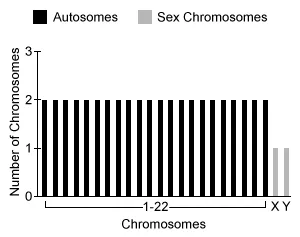
|
|
B.
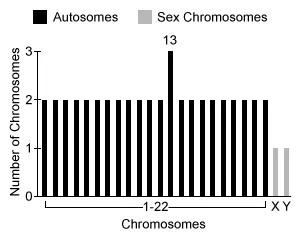
|
|
C.

|
|
D.
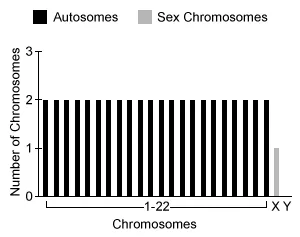
|
Explanation
Gametes (eggs and sperm) form via meiosis, a process of cell division in which a single diploid (2n) parental cell divides to form four haploid (1n) daughter cells. Meiosis occurs in two stages:
-
Meiosis I: Homologous chromosomes align and are separated to opposite poles of the cell by spindle fibers. Cytoplasmic division (cytokinesis) then yields two haploid cells.
-
Meiosis II: In each cell resulting from meiosis I, chromosomes align, and sister chromatids are pulled apart by spindle fibers. Cytokinesis then yields four haploid gametes.
Nondisjunction is an error in meiosis that arises when either homologous chromosomes or sister chromatids fail to separate, producing gametes with missing or extra chromosomes that can be passed to offspring, leading to genetic disorders in humans.
The question asks which graph best represents the number of chromosomes present in human offspring in the absence of nondisjunction. Humans typically have 23 pairs of chromosomes, including a pair of sex chromosomes (ie, XX in females or XY in males). Choice A depicts 22 pairs of autosomes (non-sex chromosomes) and a pair of sex chromosomes (one X and one Y), as would be found in male offspring when nondisjunction of chromosomes or chromatids did not occur.
(Choices B, C, and D) These graphs depict offspring possessing either extra copies of chromosome 13 or 18 or missing an X chromosome.
Things to remember:
During meiosis, nondisjunction occurs when homologous chromosomes (in meiosis I) or sister chromatids (in meiosis II) fail to separate, resulting in gametes with missing or extra chromosomes. Nondisjunction can cause genetic disorders in humans.
Question
The Durham breed of cattle (Bos taurus) possesses two codominant alleles, white and red, for an autosomal coat-color gene. If each codominant allele is expressed when present, what percentage of offspring are expected to produce coats containing red hairs and white hairs when true-breeding white Durham cattle are mated with true-breeding red Durham cattle?
| A. 0% | |
| B. 25% | |
| C. 75% | |
| D. 100% |
Explanation
The alleles inherited by an organism strongly influence the organism's phenotype. Mendel's laws of segregation and independent assortment explain patterns of inheritance based on transmission of dominant or recessive alleles from parents to offspring.
However, some traits exhibit non-Mendelian inheritance patterns. For example, traits controlled by genes on sex chromosomes or outside the nucleus are not inherited equally by males and females. Also, genes located close to each other on a chromosome are frequently inherited together, deviating from Mendel's law of independent assortment. Finally, traits may be controlled by multiple genes or alleles or influenced by the organism's environment or life history (ie, by epigenetics).
The question asks the expected percentage of offspring exhibiting coats with red hairs and white hairs when true-breeding white and true-breeding red Durham cattle are mated. Because codominant alleles are both fully expressed in heterozygotes, true-breeding white and true-breeding red cattle must be homozygous for white and red alleles, respectively.
Therefore, since all offspring inherit one allele from each parent, 100% of the offspring of white and red parents are expected to be heterozygous for the coat-color gene and exhibit coats with red hairs and white hairs.
(Choices A, B, and C) 0%, 25%, and 75% do not reflect the expected pattern of phenotype inheritance.
Things to remember:
Divergence from the expected (Mendelian) distribution of offspring phenotypes suggests non-Mendelian inheritance.
Stand Out
with a Top Score in AP Biology
Finish your Unit 5 AP Biology review and continue mastering all units with UWorld. Boost your performance and set yourself apart as a strong candidate for competitive colleges, majors, and scholarships by earning a top score.
Get our all-in-one course today!
- Focused AP Bio Videos
- Print & Digital Study Guide
- 500+ Exam-style Practice Questions
- Customizable Quiz Generator
- Adjustable Study Planner
- Realistic Timed Test Simulation
- Colorful Visual Explanations
- Progress Dashboard
- Smart Flashcards & Digital Notebook
Hear From Our AP Students

UWorld’s service is pretty good and helps provide a lot of explanations on subjects I haven’t been confident on before.

The questions here are the most realistic to the AP tests I've seen so far! I appreciate the ability to customize tests as well.

The best part is that all options are well-explained, telling clearly why they are the right option.
Frequently Asked Questions (FAQs)
What is AP Bio Unit 5: Heredity, and why is it important for the exam?
AP Biology Unit 5 focuses on how traits are passed from parents to offspring through predictable genetic mechanisms. It connects directly to many concepts tested in AP Bio Unit 5 FRQs and AP Bio Unit 5 MCQs, including segregation, independent assortment, and genetic variation. A strong grasp of heredity is crucial because it underlies not only this unit but also later topics in gene expression and natural selection.
Students should begin their AP Biology Unit 5 review with meiosis, the process that produces gametes and drives genetic diversity. Move from this foundation into Mendelian inheritance and its exceptions, such as codominance and incomplete dominance. Review chromosomal disorders, linkage, and recombination using the AP Bio Unit 5 study guide for a structured outline of key terms and definitions. Apply this knowledge by solving AP Biology Unit 5 progress check MCQs, which mirror the type of logic-based questions found in the real exam.
UWorld practice questions reinforce these ideas through applied scenarios that simulate test conditions. They combine visual diagrams with step-by-step reasoning so students understand how variation arises and why specific outcomes appear in genetic crosses. This creates a study environment that blends conceptual clarity with exam precision.
What topics are covered in AP Biology Unit 5: Heredity?
The AP Biology Unit 5 review centers on the principles of inheritance, genetic diversity, and the chromosomal basis of heredity. Students study the mechanisms of meiosis, the behavior of alleles, and how genotypes create observable phenotypes. Major themes include Mendelian and non-Mendelian inheritance, chromosomal linkage, recombination, and environmental effects on trait expression. These topics appear consistently in AP Bio Unit 5 FRQs and AP Bio Unit 5 MCQs.
A complete AP Bio Unit 5 study guide divides these themes into manageable sections. Begin with meiosis and its connection to variation, then examine classic Mendelian crosses before moving into polygenic traits and gene interactions. Next, analyze recombination frequency and chromosomal behavior. End each review cycle with an AP Bio Unit 5 practice test to test recall and reasoning.
UWorld study guides and practice questions follow the same logical progression as the official College Board curriculum. Their diagrams and applied examples reinforce each concept by turning abstract rules into interpretable results, helping students connect definitions to biological outcomes.
How should I study for AP Biology Unit 5 to master heredity concepts?
Studying heredity requires a combination of conceptual understanding, structured review, and data-based reasoning. Begin your AP Biology Unit 5 review by mastering the sequence of meiosis and identifying where genetic diversity originates. Move on to Mendelian principles, including segregation and independent assortment, and then explore exceptions such as incomplete dominance and codominance. This structure supports your performance on both AP Bio Unit 5 FRQs and AP Bio Unit 5 MCQs.
Create a rhythm that alternates between reading and application. Study one concept from your AP Bio Unit 5 study guide each day, then test it through AP Biology Unit 5 progress check MCQs. Review incorrect answers and summarize what concept caused confusion. Each week, schedule one AP Bio Unit 5 practice test to consolidate what you learned.
UWorld practice questions offer strong reinforcement for this cycle because they explain each heredity problem through data interpretation. Students not only check whether an answer is right but also learn how to construct logical explanations for why traits appear in certain ratios. This cultivates the exact reasoning the FRQs demand.
What is the best study sequence for mastering AP Biology Unit 5?
The AP Biology Unit 5 review is most effective when structured in a sequence that reflects how the content builds conceptually. Start with meiosis, since understanding cell division clarifies every later topic in heredity. Then study Mendelian genetics and probability, followed by polygenic and non-Mendelian inheritance. Finish with chromosomal mutations and recombination analysis. Each step supports the next and helps you navigate AP Bio Unit 5 FRQs and AP Bio Unit 5 MCQs with confidence.
A practical order might include:
- Meiosis and crossing over
- Mendelian inheritance and expected ratios
- Probability and chi-square analysis
- Gene linkage and recombination
- Chromosomal mutations
- Timed review through AP Biology Unit 5 progress check MCQs and AP Bio Unit 5 practice tests
This sequencing ensures you see heredity as an integrated system rather than a list of definitions. UWorld study guides are structured in the same order, helping students move logically from concept to application while reinforcing cross-topic understanding through practice questions.
How should I plan my last two weeks before the AP Bio Unit 5 test?
The last two weeks before the test should focus on integration and simulation. Start your AP Biology Unit 5 review by revisiting core diagrams in your study guide. Summarize meiosis, Mendelian ratios, and recombination in concise notes. During the first week, review content for 60 minutes a day and spend another 30 minutes on AP Biology Unit 5 progress check MCQs.
In the second week, transition into timed practice. Take two AP Bio Unit 5 practice tests; one midweek and one during the weekend, to evaluate pacing and accuracy. Review incorrect questions immediately and rewrite explanations for any unclear logic. Add low-volume reinforcement materials such as downloadable AP Bio Unit 5 notes or heredity summary sheets for quick refreshers before the test.
UWorld practice questions mirror the timing and structure of the actual AP exam, making them ideal for final-stage training. They guide you through reasoning under pressure and help close knowledge gaps in the last few study sessions.
What are the main FRQ question types in AP Bio Unit 5?
The FRQs in AP Biology Unit 5 measure a student’s ability to apply genetics reasoning to unfamiliar data. The main types include Mendelian prediction problems, recombination frequency analysis, pedigree interpretation, and probability justification using chi-square. These patterns appear in AP Bio Unit 5 FRQs and overlap with AP Bio Unit 5 MCQs and AP Biology Unit 5 progress check MCQs, which reinforce reasoning through smaller, structured tasks.
To prepare, write one FRQ every few days and review it as if you were grading it. Focus on clarity, logical flow, and evidence-based explanations. Organize each response with short paragraphs that mirror how graders evaluate points: concept, evidence, and reasoning. Reinforce this by reading model answers from your AP Bio Unit 5 study guide and rewriting them in your own words.
UWorld practice questions replicate this analytical process by training you to defend conclusions rather than memorize them. Their genetics problems encourage a habit of structured explanation that naturally transfers to full-length FRQs, improving both accuracy and concision.
How can I improve my score on AP Biology Unit 5 progress check MCQs?
Improving your performance on AP Biology Unit 5 progress check MCQs depends on strategy, not just content. Start by identifying patterns in your errors. Determine whether the issue lies in concept confusion, misreading questions, or running out of time. Then, align your review with the AP Bio Unit 5 study guide to fill conceptual gaps. Focus on meiosis, Mendelian inheritance, and probability because these appear most frequently in AP Bio Unit 5 FRQs and AP Bio Unit 5 MCQs.
When practicing, create a small error log. After every progress check session, record which topics caused trouble and what reasoning mistake you made. Over time, you’ll notice repeating trends. Review those sections, then reattempt similar questions within a few days. Reinforcement through spaced repetition improves retention.
UWorld practice questions are valuable here because each explanation isolates why wrong answers seem right. By studying that logic, you strengthen question interpretation skills and build the mental speed needed to eliminate distractors under exam conditions.
How are heredity and meiosis connected in AP Biology Unit 5?
Meiosis forms the foundation of heredity because it explains how alleles separate and recombine to produce variation. The AP Biology Unit 5 review emphasizes this process repeatedly, linking it to genetic diversity and the probability outcomes seen in AP Bio Unit 5 MCQs and AP Bio Unit 5 FRQs. Without understanding meiosis, inheritance patterns like independent assortment or crossing over remain abstract.
Study each stage carefully using your AP Bio Unit 5 study guide. Note where homologous chromosomes pair, exchange genetic material, and divide. Connect these cellular events to observable outcomes such as genotype ratios and recombination frequencies. Use AP Biology Unit 5 progress check MCQs that focus specifically on meiosis to test your understanding of sequence and cause.
UWorld practice questions pair meiosis visuals with applied genetics problems, showing how cellular events shape inheritance. This integration turns complex diagrams into reasoning exercises that make heredity more intuitive and exam-ready.
How can I retain complex processes and genetic patterns in AP Bio Unit 5?
Retention depends on active repetition and context-based study. AP Biology Unit 5 review covers intricate processes such as recombination, linkage, and epistasis that can be difficult to memorize. To retain them, visualize each process as a story of cause and effect. Connect how an event in meiosis leads to a particular outcome in phenotypic ratios.
Use a cycle of review, recall, and testing. Start by reading your AP Bio Unit 5 study guide, then close it and recite the process aloud. Follow this with a short set of AP Biology Unit 5 progress check MCQs on the same topic. Finally, review one heredity FRQ to see how that concept appears in writing. Apply this approach every few days.
UWorld study guides and practice questions reinforce complex material through layered explanations that link diagrams to logic. Seeing processes unfold across multiple question types helps store them in long-term memory without the need for constant rereading.
How do I study Punnett squares and probability for the Unit 5 test?
Punnett squares and probability calculations form the mathematical side of heredity. The AP Biology Unit 5 review emphasizes understanding ratios rather than memorizing them. Students must know how allele combinations produce predictable genotypes and phenotypes. These calculations appear in AP Bio Unit 5 MCQs, FRQs, and progress check MCQs, making them essential for the exam.
Start with simple monohybrid crosses to review dominance and recessiveness, then move to dihybrid problems that combine traits. Track expected versus observed ratios, and practice chi-square analysis to test accuracy. The AP Bio Unit 5 study guide usually provides formula summaries that are worth memorizing. Reinforce those equations through application in an AP Bio Unit 5 practice test.
UWorld practice questions train the same skill by blending probability with context. Instead of asking for direct ratios, they embed numerical reasoning within experimental data, teaching you to extract relationships quickly and apply the logic accurately.
What is the best AP Biology Unit 5 practice test format?
The best AP Bio Unit 5 practice test format mirrors the real exam’s timing and structure. Each test should include both multiple-choice and free-response sections. Aim for 60 minutes of MCQs followed by 25 minutes of FRQs. A full-length test helps evaluate comprehension, pacing, and endurance, which are as critical as content mastery.
For your AP Biology Unit 5 review, combine one timed test per week with ongoing topic-specific practice. Review your results by category rather than by score. This helps identify which content areas—meiosis, inheritance, probability, or mutations require deeper review. Link your corrections to sections in the AP Bio Unit 5 study guide to create a targeted improvement plan.
UWorld practice tests follow this structure precisely. They combine timing analytics with detailed explanations, turning each session into both an assessment and a study activity. This familiarity with exam rhythm strengthens pacing confidence during the official test.
When should I begin preparing for the AP Bio Unit 5 test?
Ideally, students should start their AP Biology Unit 5 review four to five weeks before the exam. This allows enough time to balance concept learning with timed practice. Begin by revisiting meiosis and Mendelian inheritance, then progress to complex genetics and recombination. Spend the final weeks practicing AP Bio Unit 5 FRQs and AP Bio Unit 5 MCQs to improve reasoning speed.
Week 1-2: Review heredity theory and basic probability using your AP Bio Unit 5 study guide.
Week 3: Start solving AP Biology Unit 5 progress check MCQs daily.
Week 4-5: Focus on test simulation with AP Bio Unit 5 practice tests under exam conditions.
Studying early helps prevent cognitive overload during the final week. UWorld study guides complement this timeline because their organized sections align with the same sequence of topics, allowing you to follow a ready-made plan without extra scheduling.
What are common mistakes students make in AP Bio Unit 5?
Common mistakes often involve skipping foundational concepts or misinterpreting data. Many students confuse genotype and phenotype, misapply chi-square results, or overlook recombination frequency. These errors lower the accuracy in both AP Bio Unit 5 MCQs and AP Bio Unit 5 FRQs. The AP Biology Unit 5 review should therefore emphasize understanding before memorization.
To avoid these mistakes, revise diagrams of meiosis and gene mapping from your AP Bio Unit 5 study guide. Practice interpreting inheritance tables carefully. In progress check MCQs, read every question fully before answering. When reviewing AP Bio Unit 5 practice test results, classify your errors by type: conceptual, calculation-based, or careless.
UWorld practice questions are particularly useful for error correction. Their explanations break down not just the correct reasoning but also the thought traps that cause mistakes, helping you develop awareness and consistency in problem-solving.
Where can I find AP Bio Unit 5 notes, cheat sheets, or study guides?
AP Biology Unit 5 notes and heredity study guides are available through multiple online and print resources. These materials summarize key topics such as meiosis, inheritance patterns, and chromosomal mutations in a concise format. When building your AP Biology Unit 5 review set, choose sources that align with College Board frameworks so that examples match the language used in the exam.
Focus on resources that combine text with visuals. Diagrams of genetic crosses and probability trees accelerate understanding. Use the AP Bio Unit 5 study guide for structured reading, and supplement it with one-page summaries or heredity cheat sheets for quick revision. Apply what you read through the AP Biology Unit 5 progress check MCQs to test your recall in context.
UWorld study guides and practice questions integrate these visuals into problem-solving, creating an active learning process where information is reinforced by use, not just exposure. This approach converts summaries into working knowledge for the test.
Are there downloadable AP Biology Unit 5 study materials and practice tests?
Yes. Many reliable platforms provide downloadable AP Biology Unit 5 notes, practice worksheets, and review packets that focus on heredity. These materials include practice tests, flashcards, and genetics summaries formatted for quick review. Choose PDFs that match AP Bio Unit 5 practice test standards so the question style remains consistent with College Board wording.
To use these materials effectively, schedule practice in intervals. Review one section from your AP Bio Unit 5 study guide, then apply it through the corresponding questions from a downloaded test. Combine this with weekly progress check MCQs for ongoing reinforcement.
UWorld practice tests are also available digitally, offering detailed feedback on each heredity question. The downloadable explanations encourage independent correction and allow students to track performance over time, turning every session into both study and self-assessment.
